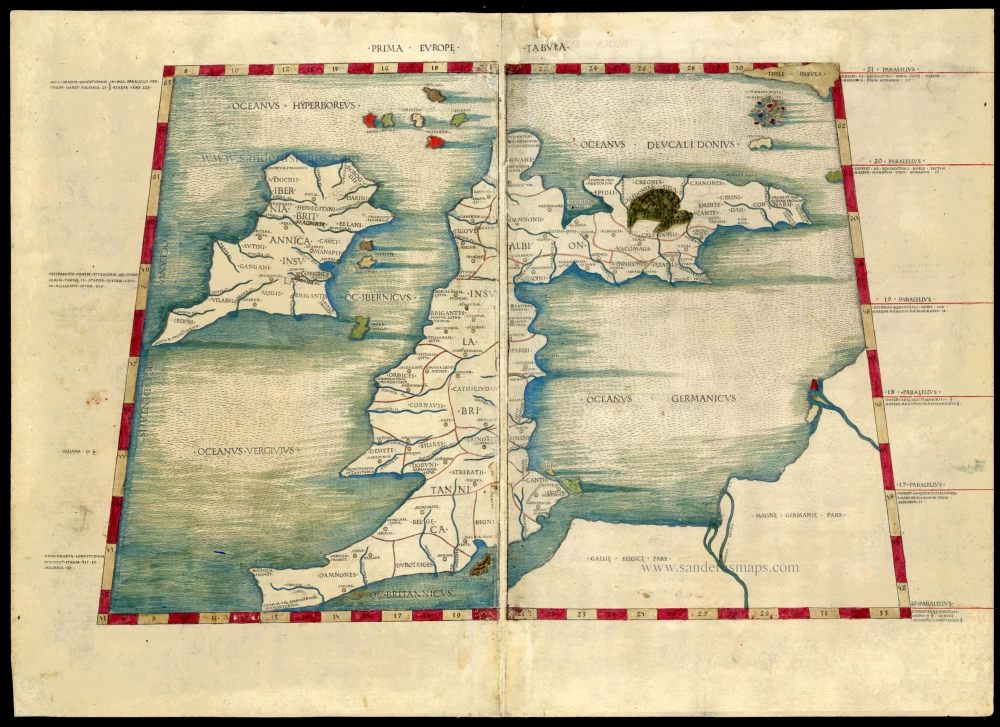Antique map of British Isles by Ptolemy 1478
Claudius Ptolemy (c.100 – c.170 AD)
Claudius Ptolemaeus was a Greek astronomer, mathematician, and geographer who lived in Alexandria in the 2nd century. His ideas influenced much of medieval astronomy and geography. He was the first to use longitudinal and latitudinal coordinates. His idea of a global coordinate system was highly influential, and we use a similar system today.
Ptolemy wrote several scientific treatises. The first is the astronomical treatise, now known as the Almagest. The second is the Geography, which is a thorough discussion of the geographic knowledge of the Greco-Roman world. The third is the Apotelesmatika, an astrological treatise in which he attempted to adapt horoscopic astrology to the Aristotelian natural philosophy of his day.
The Geographia is a compilation of geographical coordinates of the part of the world known to the Roman Empire during his time. However, the maps in surviving manuscripts of Ptolemy's Geography only date from about 1300, after Maximus Planudes rediscovered the text. It seems likely that the topographical tables are cumulative texts that were altered and added to as new knowledge became available in the centuries after Ptolemy.
The earliest printed edition with engraved maps was produced in Bologna in 1477, followed quickly by a Roman edition in 1478. An edition printed at Ulm in 1482, including woodcut maps, was the first one published north of the Alps.
Prima Europa Tabula
Item Number: 20923 Authenticity Guarantee
Category: Antique maps > Europe > British Isles
First available printed map of the British Isles based on trapezoidal prototype map of Nicolaus Germanus. Engraved under supervision of Conrad Sweynheim. Published in Rome by Buckinck.
Copper engraving, printed from two plates.
Size (not including the title and letterpress in margins): Size: 38 x 42cm (15 x 17 inches)
Sheet size: 41.5 x 57.5cm (16.3 x 22.6 inches)
Verso: Blank
Condition: Old coloured, small repair in the middle of the upper margin.
References: Shirley (BI to 1750), 2; Karrow, 32/7; Nordenskiöld, 197; Shirley (Brit.Lib.), T.Ptol.2a
From: Claudii Ptolemaei Alexandrini philosophi Geographiam Romae. Rome, 1478.
"The new copper plates engraved at Rome for the 1478 edition of Ptolemy's 'Geography' are much superior in clarity and craftsmanship to those of the Bologna edition. There is evidence that work on the Rome edition had been started in 1473 or 1474, and several of the plates may well have been engraved before those printed at Bologna in 1477. The printing was carried out by two skilled printers of German origin: Conrad Sweynheym and his successor Arnold Buckinck; the publisher was Domitius Calderinus. Many consider the Rome plates to be the finest Ptolemaic plates produced until Gerard Mercator engraved his classical world atlas of 1578." (Shirley)
"Until the 1477 edition was definitively dated, this edition was thought to be the oldest engraved atlas. It was printed by Arnoldus Buckinck, and is thought to be the only known book with his imprint. At first the engraving was supervised by a German, Conrad Sweynheym of Main (d. 1477). His method of using a printingpress for the copperplate maps, together with the fine engraving, produced an excellent result. The text was edited by Domitius Calderinus of Verona; he collated various Latin manuscript in the translation by Jacobus Angelus with an ancient Greek Manuscript, which had been emended by Geirgius Gemistus (d. 1450). Calderinus was a careful worker, and his edition had been much admired for the correctness of the text, the fine typography and the brilliant engraving. Christopher Colombus owned a copy of this edition, which he annotated. The run of the edition is not known, but it is considered to be scarce, and is therefore rare and important. ..." (Nordenskiöld)
Claudius Ptolemy (c.100 – c.170 AD)
Claudius Ptolemaeus was a Greek astronomer, mathematician, and geographer who lived in Alexandria in the 2nd century. His ideas influenced much of medieval astronomy and geography. He was the first to use longitudinal and latitudinal coordinates. His idea of a global coordinate system was highly influential, and we use a similar system today.
Ptolemy wrote several scientific treatises. The first is the astronomical treatise, now known as the Almagest. The second is the Geography, which is a thorough discussion of the geographic knowledge of the Greco-Roman world. The third is the Apotelesmatika, an astrological treatise in which he attempted to adapt horoscopic astrology to the Aristotelian natural philosophy of his day.
The Geographia is a compilation of geographical coordinates of the part of the world known to the Roman Empire during his time. However, the maps in surviving manuscripts of Ptolemy's Geography only date from about 1300, after Maximus Planudes rediscovered the text. It seems likely that the topographical tables are cumulative texts that were altered and added to as new knowledge became available in the centuries after Ptolemy.
The earliest printed edition with engraved maps was produced in Bologna in 1477, followed quickly by a Roman edition in 1478. An edition printed at Ulm in 1482, including woodcut maps, was the first one published north of the Alps.

